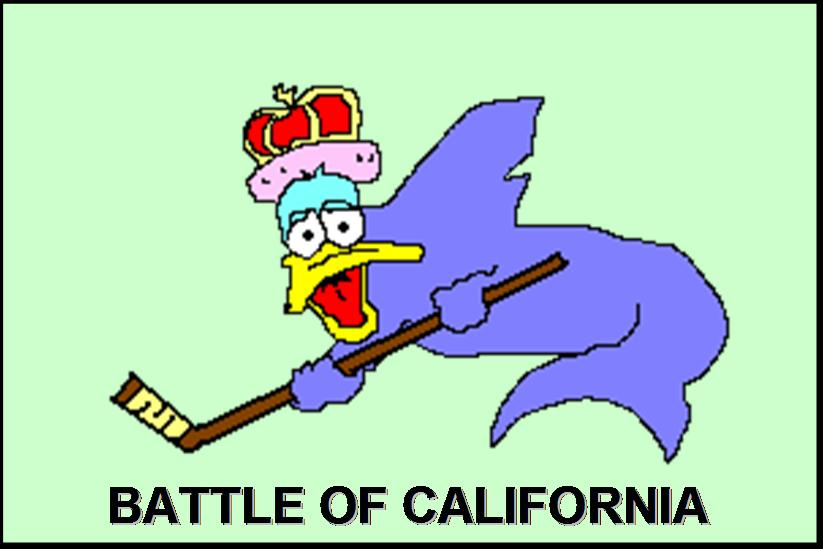On winning vs. boring, part 2
[Edit: one other motivation for these posts (other than having not much positive to say on the Ducks thus far) is that in Southern California, with the Clippers now eliminated and the Angels playing horrible baseball, the Ducks should now get more local attention. The way the games are going now, I'm not sure that's a good thing. I have two friends coming over today who know very little about hockey; I'm afraid to try to sell this sport too well lest the game turn into another stinker.]
Just a few more thoughts on this subject, and some related ones. I meant to post these earlier, but was interrupted by the stupid day job.
- I like that there is a rules committee, but I am not sure about the personnel they invited. I don't know if the league's problems were getting Shanahan enough scoring chances, but rather the overall mindset of the game. If I had a rules committee, I would definitely invite Darryl Sutter and pose to him the following questions: "What rules in today's game enables your team to sit on a lead so effectively? What rule changes would encourage you to pursue a 2-goal lead rather than sit on 1?" His input matters more to me than Mark Crawford's.
- It has bothered me all year that the league decided on so many rule changes at once, in that it becomes near-impossible to test what has worked vs. what hasn't. In particular, I still have no idea how to feel about allowing 2-line passes. While once every couple of games it seems to work for something, how much is it costing us to defend? What is the inherent sacrifice that needs to be made on an offensive end to properly (or even improperly) defend a 2-line pass? Had this been the only rule change, we would know the answer to this better.
- To me, a lot of the problem comes from the blue line, even with the addition of tag-up offsides. Defensive systems are very dependent on the rules that dictate that the puck must enter the offensive zone before any player, and once the puck is in it becomes a game of "get it over the line before it gets in our net", which for the most part is a very winnable game. I don't know what the solution is, but if I had the job of making hockey more watchable, it would probably involve a rule change about the blue line. It may even be something very dramatic, like if the puck crosses center ice then one skater is allowed to be offsides. If nothing else, that would change the way things are defended.
- However rule changes happen, there needs to be incentive built into the whole thing. A coach gets hired and fired based on winning and losing, not based on TV ratings. Players get paid for signing a contract, not for delivering anything. A team that plays defense well enough has no incentive to see another goal scored once they get a one-goal lead. Bottom line (no matter how it happens): there needs to be more incentive for a team with a one-goal lead to try to make it two.
- (random question) Remembering that I have never played hockey, I wonder why there is still a rule about the curvature allowed on a hockey stick, especially given the offensive push the league decided to make. What is the danger of having a stick too curved? Too good a shot?









9 comments:
I played hockey as a kid, but i never really understood the curved stick rule either...
My thoughts:
Mabye if they abolished the rule, players who have a tough time retaining the puck would curve their stick around into a circle, and make a puck wall.
The puckwall curve, as it is to be now known, will be picked up internationally, but will soon become all the rage in Anaheim so Todd Marchant might actually have a shot of putting a puck in the net on a breakaway.
Realizing that they are now playing a game similar to ringette, Anaheim will withdraw from the NHL in favour of greener pastures with the NRL, albiet their overt maleness.
I can guarantee Rodney Dangerfield - "Ladybugs" hilarity would ensue.
I'm not sure, but I think the stick limitations were put in before goalies had good protection. I think the league was afraid a goalie would get killed by a Bobby Hull slapshot.
I'm not sure, but I think the stick limitations were put in before goalies had good protection. I think the league was afraid a goalie would get killed by a Bobby Hull slapshot.
Hull's velocity alone might have been enough to cause a fatality back in the 60's. Even when goalies began wearing masks, the 70's and early-80's designs were of marginal help in combating a heavy shot.
A super-curved stick has some effect on the aerodynamics of puck flight that causes the disc to 'knuckle-ball'. A flush-on 90-mph slapshot is bad enough. A 90-mph slapshot that (pre-'85, before the bird-cage mask became popular) netminders lost sight of at the last minute is inviting catastrophe.
Stick curvature rules can be mothballed:
(a) todays masks appear to make the goalie bullet-proof
(b) any serious player (Bantam travel & beyond) knows that stickhandling and passing are far more important hockey skills than having the highest-velocity slapshot, and the former require very modest curves.
(a) todays masks appear to make the goalie bullet-proof
True
Kipper just got up and dusted himself off after Beauchemin took off his mask from 40 feet away.
(b) any serious player (Bantam travel & beyond) knows that stickhandling and passing are far more important hockey skills than having the highest-velocity slapshot, and the former require very modest curves.
How does a curve affect stickhandling? Would a player like Samsonov become all the more dangerous (all the more entertaining) if he could have more curve on his stick? Or would he just use what he has today?
It seems weird to me that players curve up to the limit. What exactly are we limiting them from doing?
Wow! How did your buddies like dem apples? NHL converts? New Oilers Fans?
The stick curvature makes stickhandling and backhands more difficult, but lets you seriously whip wristers.
It wasn't so much the slappers that were more dangerous, it was the wristers -- with a wicked curve you can just sling those babies head high with some serious velocity and spin.
Lots of the old school guys will tell you that the young pups already can't use their backhand and that removing the curve would make it even worse.
It was the '56 Habs, but yeah, point taken.
While the effect on wristers is probably more useful, when the WHA was around, they had no curvature rules, thanks to Bobby Hull, and *everyone* used slapshots. (Subtlety was not one of the WHA's strong suits, particularly in the early years, which I quickly learned when I read up about it.) But as noted, the goalies are nearly invincible against pucks, and with more and more players wearing visors, the only danger left is Smytty leaving more teeth on the ice. And we all know what happens when he does that...
Getting rid of the 2-line pass rule was great. I haven't noticed teams playing less aggressively in the offensive-zone to specifically defend against the 2-line pass. I'm seeing alot more breakaways and 1-on-1's this year. I submit that fantastic Roloson hail-mary to Peca as evidence.
Anyway, the rule changes have been working for the most part. I don't think allowing players to have insanely curved sticks would help that much. If they really wanted to do something about the sticks they should ban those one-piece sticks that explode all the time.
I haven't noticed teams playing less aggressively in the offensive-zone to specifically defend against the 2-line pass.
I'm not sure if it's the kind of thing you can notice. It might take its effects in something like a defenseman *not* pinching or *not* being there to hold the blue line.
It's a tough question, because the times it works (Roloson), it is noticeable. But that probably isn't the only effect of the rule change.
Post a Comment